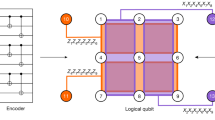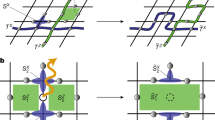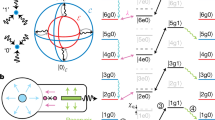Abstract
Scalable quantum computation1 and communication require error control to protect quantum information against unavoidable noise. Quantum error correction2,3 protects information stored in two-level quantum systems (qubits) by rectifying errors with operations conditioned on the measurement outcomes. Error-correction protocols have been implemented in nuclear magnetic resonance experiments4,5,6, but the inherent limitations of this technique7 prevent its application to quantum information processing. Here we experimentally demonstrate quantum error correction using three beryllium atomic-ion qubits confined to a linear, multi-zone trap. An encoded one-qubit state is protected against spin-flip errors by means of a three-qubit quantum error-correcting code. A primary ion qubit is prepared in an initial state, which is then encoded into an entangled state of three physical qubits (the primary and two ancilla qubits). Errors are induced simultaneously in all qubits at various rates. The encoded state is decoded back to the primary ion one-qubit state, making error information available on the ancilla ions, which are separated from the primary ion and measured. Finally, the primary qubit state is corrected on the basis of the ancillae measurement outcome. We verify error correction by comparing the corrected final state to the uncorrected state and to the initial state. In principle, the approach enables a quantum state to be maintained by means of repeated error correction, an important step towards scalable fault-tolerant quantum computation using trapped ions.
This is a preview of subscription content, access via your institution
Access options
Subscribe to this journal
Receive 51 print issues and online access
$199.00 per year
only $3.90 per issue
Buy this article
- Purchase on Springer Link
- Instant access to full article PDF
Prices may be subject to local taxes which are calculated during checkout



Similar content being viewed by others
References
Preskill, J. Reliable quantum computers. Proc. R. Soc. Lond. A 454, 385–410 (1998)
Calderbank, A. R. & Shor, P. W. Good quantum error-correcting codes exist. Phys. Rev. A 54, 1098–1105 (1996)
Steane, A. Multiple particle interference and quantum error correction. Proc. R. Soc. Lond. A 452, 2551–2577 (1996)
Cory, D. G. et al. Experimental quantum error correction. Phys. Rev. Lett. 81, 2152–2155 (1998)
Leung, D. et al. Experimental realization of a two-bit phase damping quantum code. Phys. Rev. A 60, 1924–1943 (1999)
Knill, E., Laflamme, R., Martinez, R. & Negrevergne, C. Benchmarking quantum computers: The five-qubit error correcting code. Phys. Rev. Lett. 86, 5811–5814 (2001)
Cory, D. G. et al. NMR based quantum information processing: Achievements and prospects. Fortschr. Phys. 48, 875–907 (2000)
Lo, H.-K. & Chau, H. F. Unconditional security of quantum key distribution over arbitrarily long distances. Science 283, 2050–2056 (1999)
Shor, P. W. Proc. 35th Annual Symp. on Foundations of Computer Science (ed. Goldwasser, S.) 124 (IEEE Computer Society Press, Los Alamitos, California, 1994)
Wineland, D. J. et al. Experimental issues in coherent quantum-state manipulation of trapped atomic ions. J. Res. Natl Inst. Stand. Technol. 103(3), 259–328 (1998)
Barrett, M. D. et al. Deterministic quantum teleportation of atomic qubits. Nature 429, 737–739 (2004)
Leibfried, D. et al. Toward Heisenberg-limited spectroscopy with multiparticle entangled states. Science 304, 1476–1478 (2004)
Riebe, M. et al. Deterministic quantum teleportation with atoms. Nature 429, 734–737 (2004)
Blinov, B. B., Moehring, D. L., Duan, L.-M. & Monroe, C. Observation of entanglement between a single trapped atom and a single photon. Nature 428, 153–157 (2004)
Nielsen, M. A. & Chuang, I. L. Quantum Computation and Quantum Information (Cambridge Univ. Press, Cambridge, UK, 2000)
Rowe, M. A. et al. Transport of quantum states and separation of ions in a dual rf ion trap. Quant. Inf. Comput. 2, 257–271 (2002)
Leibfried, D. et al. Experimental demonstration of a robust, high-fidelity geometric two ion-qubit phase gate. Nature 422, 412–415 (2003)
Wineland, D. J. et al. Quantum information processing with trapped ions. Phil. Trans. R. Soc. Lond. A 361, 1349–1361 (2003)
Schaetz, T. et al. Quantum dense coding with atomic qubits. Phys. Rev. Lett. 93, 040505 (2004)
King, B. E. et al. Cooling the collective motion of trapped ions to initialize a quantum register. Phys. Rev. Lett. 81, 1525–1528 (1998)
Acknowledgements
We thank T. Rosenband and D. Rosenberg for comments on the manuscript. This work was supported by the US National Security Agency (NSA) and the Advanced Research and Development Activity (ARDA). This manuscript is a publication of NIST.
Author information
Authors and Affiliations
Corresponding author
Ethics declarations
Competing interests
The authors declare that they have no competing financial interests.
Rights and permissions
About this article
Cite this article
Chiaverini, J., Leibfried, D., Schaetz, T. et al. Realization of quantum error correction. Nature 432, 602–605 (2004). https://doi.org/10.1038/nature03074
Received:
Accepted:
Issue Date:
DOI: https://doi.org/10.1038/nature03074
This article is cited by
-
Quantum power iteration to efficiently obtain the dominant eigenvector from diagonalizable nonnegative matrices
Quantum Information Processing (2024)
-
Review of Applications of Quantum Computing in Power Flow Calculation
Journal of Electrical Engineering & Technology (2024)
-
Beating the break-even point with a discrete-variable-encoded logical qubit
Nature (2023)
-
Time-series quantum reservoir computing with weak and projective measurements
npj Quantum Information (2023)
-
Optical demonstration of quantum fault-tolerant threshold
Light: Science & Applications (2022)
Comments
By submitting a comment you agree to abide by our Terms and Community Guidelines. If you find something abusive or that does not comply with our terms or guidelines please flag it as inappropriate.



